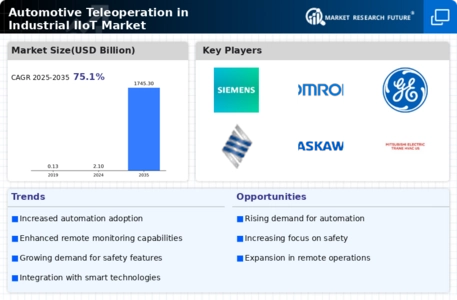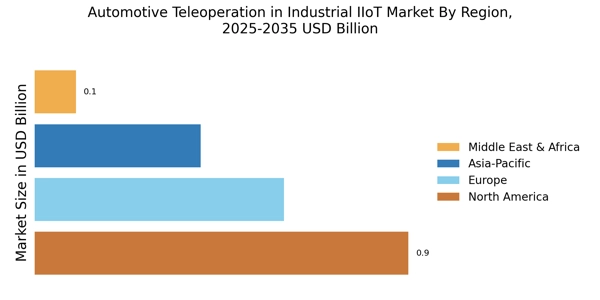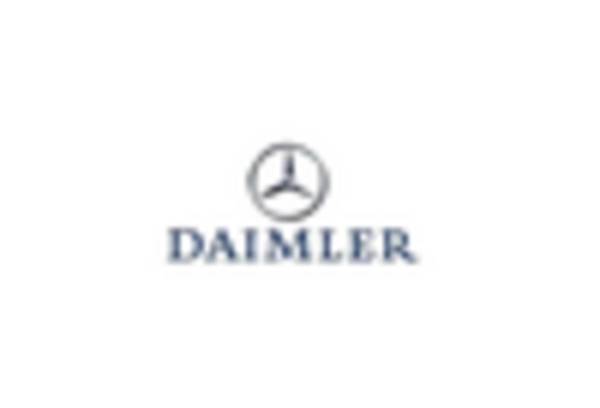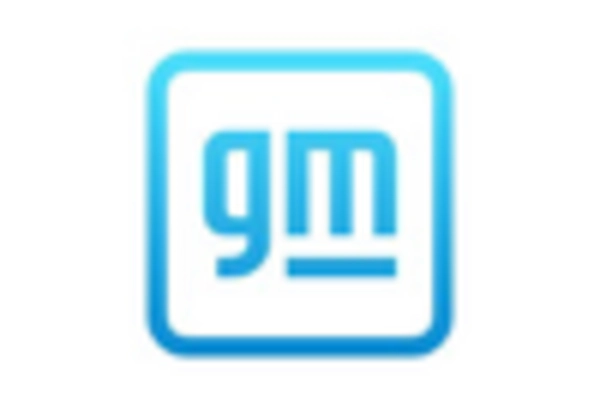Growing Demand for Automation
The Automotive Teleoperation in Industrial IIoT Market is experiencing a notable surge in demand for automation solutions. Industries are increasingly recognizing the potential of teleoperation to enhance operational efficiency and reduce labor costs. According to recent data, the automation market is projected to grow at a compound annual growth rate of approximately 10% over the next five years. This trend is driven by the need for streamlined processes and improved productivity. Teleoperation allows for remote control of vehicles and machinery, enabling operators to manage multiple tasks simultaneously. As industries strive for greater efficiency, the integration of teleoperation technologies becomes essential. This growing demand for automation is likely to propel the Automotive Teleoperation in Industrial IIoT Market forward, as companies seek innovative solutions to remain competitive.
Increased Focus on Safety and Compliance
The Automotive Teleoperation in Industrial IIoT Market is witnessing an increased focus on safety and compliance regulations. As industries strive to minimize workplace accidents and ensure regulatory adherence, teleoperation technologies offer a viable solution. By allowing operators to control machinery from a safe distance, the risk of injury is significantly reduced. Furthermore, compliance with safety standards is becoming more stringent, prompting companies to invest in teleoperation systems that meet these requirements. Data suggests that industries implementing teleoperation solutions have reported a decrease in workplace incidents by up to 30%. This emphasis on safety not only protects workers but also enhances operational efficiency, making teleoperation an attractive option for businesses. As a result, the Automotive Teleoperation in Industrial IIoT Market is likely to expand as companies prioritize safety and compliance.
Advancements in Communication Technologies
Advancements in communication technologies are playing a pivotal role in shaping the Automotive Teleoperation in Industrial IIoT Market. The proliferation of 5G networks and enhanced wireless communication protocols facilitate real-time data transmission and remote control capabilities. This technological evolution enables operators to manage vehicles and equipment from considerable distances, thereby increasing operational flexibility. Recent studies indicate that the implementation of 5G in industrial applications could reduce latency to as low as one millisecond, significantly improving response times. As industries adopt these advanced communication technologies, the demand for teleoperation solutions is expected to rise. Consequently, the Automotive Teleoperation in Industrial IIoT Market stands to benefit from these advancements, as they enhance the feasibility and reliability of remote operations.
Rising Need for Remote Monitoring and Control
The rising need for remote monitoring and control is a key driver in the Automotive Teleoperation in Industrial IIoT Market. As industries increasingly operate in complex environments, the ability to monitor and control operations from a distance becomes essential. Teleoperation technologies enable real-time oversight of machinery and vehicles, allowing for prompt decision-making and issue resolution. Recent market analyses indicate that the demand for remote monitoring solutions is expected to grow by over 15% annually. This trend is fueled by the desire for operational transparency and the ability to respond swiftly to changing conditions. Consequently, the Automotive Teleoperation in Industrial IIoT Market is poised for growth as businesses seek to implement remote monitoring capabilities to enhance their operational resilience.
Integration of Artificial Intelligence and Machine Learning
The integration of artificial intelligence (AI) and machine learning (ML) into teleoperation systems is transforming the Automotive Teleoperation in Industrial IIoT Market. These technologies enable systems to learn from data and improve decision-making processes, enhancing the overall efficiency of teleoperation. AI and ML can analyze vast amounts of data in real-time, allowing for predictive maintenance and optimized operations. Recent forecasts suggest that the AI market in industrial applications will reach a valuation of over 100 billion dollars by 2026. This integration not only streamlines operations but also reduces downtime and operational costs. As industries increasingly adopt AI and ML technologies, the Automotive Teleoperation in Industrial IIoT Market is likely to experience substantial growth, driven by the demand for smarter, more efficient teleoperation solutions.


















Leave a Comment